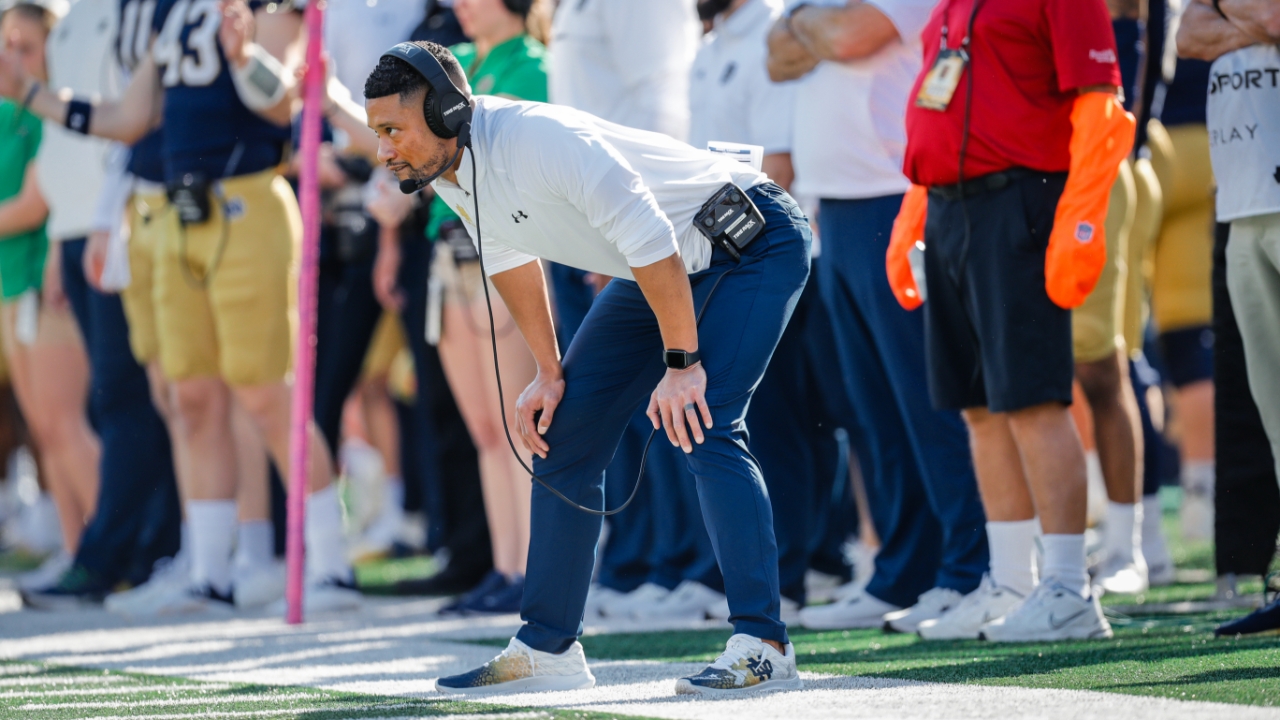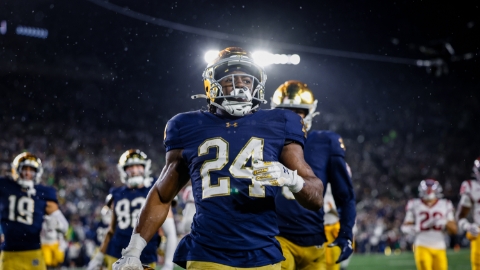
It’s a lot more fun to learn lessons while not playing well and winning than it is to not play well and lose, but Marcus Freeman had to deal with the second option after his team dropped their third game of the season to a bad Stanford team.
It was easy to project that Notre Dame would struggle after that because that’s the kind of thing that a lot of teams do after they lose a game they were supposed to win.
The Irish have gone the opposite direction since then, though. They have leaned hard into a physical running game on offense and have gotten better on defense. It now seems more likely that they can win out rather than drop a game they shouldn’t to finish the season.
How does that happen when things are going bad? We’ve seen things spiral in a bad direction before and it would be easy for a mostly new staff to start questioning each other when things are rough. It’s also easy for players to look for the easy way out when they don’t see a light at the end of the tunnel.
If I had to pick the number one reason why Notre Dame has turned things around since that Stanford loss, it would be the influence of the man in charge of the program.
Freeman could have gone the route that a lot of other coaches have traveled before. He could have pointed his finger at his own staff or taken subtle jabs at his player in the media. But he never took that path. He might have had hard conversations with people behind closed doors, but he never played the blame game publicly.
That’s something that matters to coaches and players. His coordinators, who have been available all season every Tuesday, followed his lead and did the same. They always pointed the finger at themselves and never at anyone else.
I loved seeing Tommy Rees come down to the field to celebrate with his players near the end of the Clemson game on Saturday. It was especially great to see him with Drew Pyne, since there seems to be this narrative out there that Rees being hard on Pyne is something that’s an issue.
That narrative, just like the one about Freeman needing to be different than the person he is to be successful as a coach, is trash. It is not an accurate reflection of Pyne and Rees’ relationship and there was visual evidence of that.
What Freeman said here has to do with that coach and that player, but this piece of it could have been an answer to why Notre Dame is now headed in the right direction to end the season rather than already thinking about spring ball.
“That’s what you’re going to get here at Notre Dame. You’re going to get real authentic relationships where sometimes the greatest display of love is discipline, but the other part is telling you I love you and I’m so dang proud of you, man.”
Players want to play for a coach who has real relationships with his players. Coaches want to work for someone who encourages these relationships as well.
Having this approach doesn’t make it a sure thing that Freeman is going to be the next coach to win a national championship at Notre Dame. It does mean he is going to attract the kind of players and coaches that can build a culture to help them accomplish that.
2. All of that leads into the recruiting ramifications of beating Clemson.
I don’t care that Clemson isn’t the same program that they were a couple of years ago. They are still a program that you have to beat if you want to get to the top of the mountain in the sport. And Notre Dame didn’t just beat them. As Dabo Swinney put it, “This was an a#^ kicking. Period.”
It’s one thing to sell hope in recruiting and it’s another to add results as part of that package. Mix all of that in with the relationships and Notre Dame’s recruiting hype train can really take off.
This isn’t about just this class. It’s about the 2024 and 2025 one as well. Beating Clemson matters for the future. Go west to Los Angeles and beat a highly ranked USC team to finish the season, then things can really get rolling.
3. Not to look too far ahead when we know that the Irish have two more games to win before they get there, but I don’t think there are too many Irish fans who aren’t thinking about that USC game.
Everyone who read 6 Thoughts last week knows that Notre Dame has won every game this season where they have controlled the time of possession. They did it again against Clemson, even with a blocked punt for a touchdown, a pick-six, and a turnover in Clemson territory taking away what would have been time that the Irish possessed the football.
It would be shocking if Notre Dame doesn’t dominate the time of possession against USC when they match up to end the season. It’s the recipe to beat them.
USC’s run defense is tragic. They’re 117th in opportunity rate, which means they allow runs of four yards or more at a higher rate than my kid watches Bluey episodes per day. (He watches it so much, one would think Disney+ pays him to watch it)
The Irish offense is 20th in opportunity rate, which is good, but when you realize that they rushed for less than four yards per carry in the first three games of the season, the realization of what they’ve done running the ball since then sets in.
250 on the ground on USC feels like an appropriate total, but the over on that number is probably a lock.
4. The offensive line is playing well and the backs have been very good, but the emergence of Mitchell Evans as an in-line blocker since he returned from injury deserves to be mentioned as well. He didn’t become a full-time tight end until he got to Notre Dame and the improvement the former high school quarterback has displayed as a blocker has been significant.
When a tight end is doing this to a defensive end at the point of attack, it changes things.
I know I was really excited about his potential as a receiver after the catch when he originally signed with the Irish and that part of his game hasn’t really been explored yet at Notre Dame. Evans and Michael Mayer together as blockers were essential parts of the win against Clemson and Evans is only scratching the surface as to how good he can be.
5. The defense is now up to 15th in DF+ (combined SP+ and FEI rankings). They ended up being 15th last year and were also 15th in 2018. The highest they finished in the last six years was 2019 (13th).
If I had said Notre Dame has a top-15 defense a few weeks ago, people might have said I was crazy. They’ve gotten better, though, and the results speak for themselves.
One thing that I don’t know if we’ve talked about enough is the pass rush. I know I’m guilty of it. I don’t think it has been this overwhelming presence by any means, but they’re quietly on pace for another 40 sack season and they’re accomplishing it with a lot less chances to get after the quarterback.
They were 33rd in sack rate last year. They are 10th this year. They were 13th in 2019, which was the best pass rush I’ve seen from Notre Dame in recent memory.
That group was scary for opposing offenses and still was even after players like Julian Okwara and Daelin Hayes were lost for the season. They aren’t as deep in 2022, but the production speaks for itself.
They are finding ways to get to the quarterback. Isaiah Foskey leads the way and it’s been others who have chipped in from week to week. It was JD Bertrand, Howard Cross, and TaRiq Bracy against Clemson and Jayson Ademilola and Jordan Botelho against Syracuse.
There’s a different kind of test this week when they play the triple option, but they still have to face Boston College (116th in sack rate) and I’d say the jury is out on USC in protection even though they haven’t given up a ton of sacks this season. They’ve played Cal, Arizona, and Arizona State and those are three of the worst teams in the country when it comes to getting after the quarterback. That has an impact on the numbers.
6. I don’t think too many Notre Dame fans watched the Clemson game and thought about Trenton Simpson all that much. That is and has been a problem for Clemson this year.
Simpson is a former 5-star recruit and was a preseason All-American. He had 12 tackles for loss last season and six sacks. He was third on the team in pressures and made a tremendous impact as a blitzer.
This year he has 0.5 TFLs. His role and position is different. He went from being a space linebacker who was frequently lined up outside of the box to moving to play inside as a Will. Frankly, he looks like a different player and clearly not in a good way.
It’s an example of how fit matters. He was excellent in his previous role and shifting to another position just makes him look like a fast player who can chase the football, but someone who isn’t a great linebacker.
Clemson had Barrett Carter who is a similar type of player to Simpson. They wanted those guys on the field at the same time so they moved Simpson to another position. We see how it’s worked out. Carter has been very good and Simpson seems miscast.
Coaching is about teaching technique and assignments. It’s about challenging players when they have to be challenged. It’s also about putting players in a position to succeed.
That’s what we’re seeing with JD Bertrand right now. His production has increased on the field lately and some of that has to do with him just being available and simply playing better. The other part is that he’s been activated more as a blitzer outside of the standard Cross Dog blitz Notre Dame has been running all season.
In the last three games he has rushed the passer 33 times. In the previous six games he only rushed the passer 25 times. I don’t think it’s a coincidence that he has produced 6.5 of his 8.5 havoc plays in these three games.
Bertrand is playing the best ball he has played at Notre Dame after being one of the players Notre Dame fans were the most frustrated with last season. He’s in the right role and the coaching staff has him attacking more in that role. The approach with him has paid off in a big way for the Notre Dame defense.
Men's Under Armour Gray Notre Dame Fighting Irish Game Day All Day Pullover Hoodie


